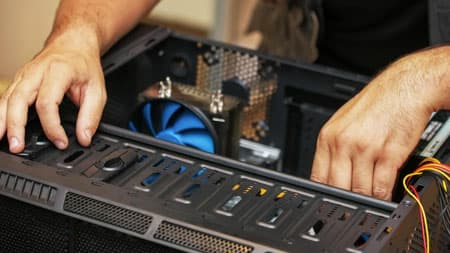When your old computer starts slowing down, humming like a vacuum cleaner, and can’t handle even basic tasks, the question arises: is it time to buy a new one? However, it doesn’t always make sense to spend money on an entirely new machine. Often, it’s much cheaper and more reasonable to “revive” an old computer — through an upgrade or repair. But how do you know which option is better? And is an upgrade really capable of giving your device a second life?
Why Do Computers Age?
Every computer gradually loses performance over time — it’s a normal process. New programs become more demanding on system resources, browsers open dozens of tabs with heavy websites, and Windows receives regular updates that consume both RAM and CPU power.
But it’s not just about software. The hardware also wears out. Thermal paste dries up, fans start making noise, and dust interferes with cooling. All of this leads to overheating and slowdowns.
When Is the Performance Drop Most Noticeable?
If you’re interested in online entertainment, we recommend visiting gaming platforms that have mobile apps or are optimized for mobile websites. This is convenient if you don’t have a working computer nearby, or if its technical specs don’t allow you to enjoy smooth gameplay. Mobile versions also offer a wide selection of games, and you can take advantage of all bonus offers, easily make deposits and withdraw your winnings — especially if you choose an azonnali kifizetes casino, where payouts are processed instantly.
Upgrade: Affordable and Effective
Upgrading means replacing individual computer components with more modern ones. This can be significantly cheaper than buying a new device, especially if your PC’s base is not yet critically outdated.
What Can Be Upgraded?
Hard Drive to SSD. One of the most effective upgrades. Solid-state drives (SSDs) are many times faster than old HDDs, which instantly speeds up system and program loading. Even an old laptop can “wake up” after this change.
RAM (Random Access Memory). Increasing memory helps the computer handle multitasking. If you have only 4 GB, it’s worth adding at least another 4–8 GB. This will allow smooth operation with browsers, office software, and lightweight graphic editors.
Thermal Paste Replacement and Dust Cleaning. These simple steps help reduce component temperature and extend their lifespan.
Graphics Card. If you work with graphics or enjoy games (including browser-based simulators or live casinos), replacing or adding a graphics card can significantly boost performance.
When Is an Upgrade Justified?
The motherboard and processor are still relevant;
The case, power supply, and other components are in working order;
The budget is limited, but you want to “boost” your system.
Repair: Is It Worth the Investment?
Sometimes, a computer slows down not because of outdated components but due to a malfunction. In such cases, you need to consult a technician — or, if you’re confident, try fixing it yourself.
What Should You Pay Attention To?
Boot Issues. Often related to corrupted system files or a damaged drive.
Noise and Overheating. You may need to replace a fan or clean the cooling system.
Blue Screen of Death. This could be either a software or hardware issue. Sometimes, reinstalling Windows helps.
If the damage is serious — for example, a burned-out processor or motherboard — the repair might cost almost as much as a new computer. In such cases, it’s worth calculating whether it’s really worth it.
Upgrade or Repair: How to Decide?
Evaluate the cost of each option. Sometimes, simply replacing the hard drive and adding RAM is enough to bring your PC back to life. In other cases, especially when there are serious malfunctions, buying a new device is simpler and more economical.
It’s also important to consider what you use your computer for. If you work with documents, listen to music, and watch movies — an upgrade is sufficient. But if you actively use graphics software, edit video, or regularly visit modern online platforms, including games, streaming, and casino online with live dealers — an upgrade might not be enough, and it’s better to think about more powerful hardware.
How to Choose Components for an Upgrade?
Here, compatibility is key. Check what types of RAM your motherboard supports, whether it has a slot for an SSD, and what kind of graphics card it can handle. It’s best to consult a specialist in advance or look up information based on your PC or laptop model.
Also, pay attention to power supply. A powerful graphics card or an additional drive may require a new PSU.
Conclusion: A Second Life for Old Tech Is Real
Don’t rush to write off your old computer. Often, it can be given a second life — and continue to serve you well as a work or entertainment machine. An upgrade is a smart solution, especially if you want to stay on budget while improving performance.
If you live in Hungary, where there is a wide range of components and repair services available, it’s not difficult to find a suitable solution — whether it’s replacing parts, consulting a technician, or buying an affordable SSD. And if you plan to use your PC for online entertainment — whether for video, communication, or even gambling on the internet — a timely upgrade is a necessity, not a luxury.


